Intriguing Insights Into Ocean Marine Life
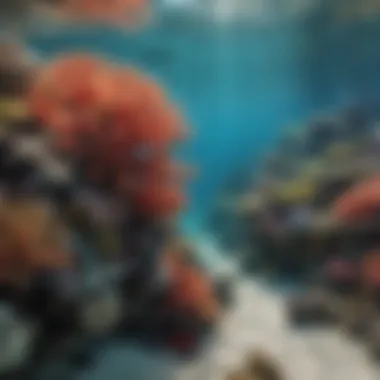
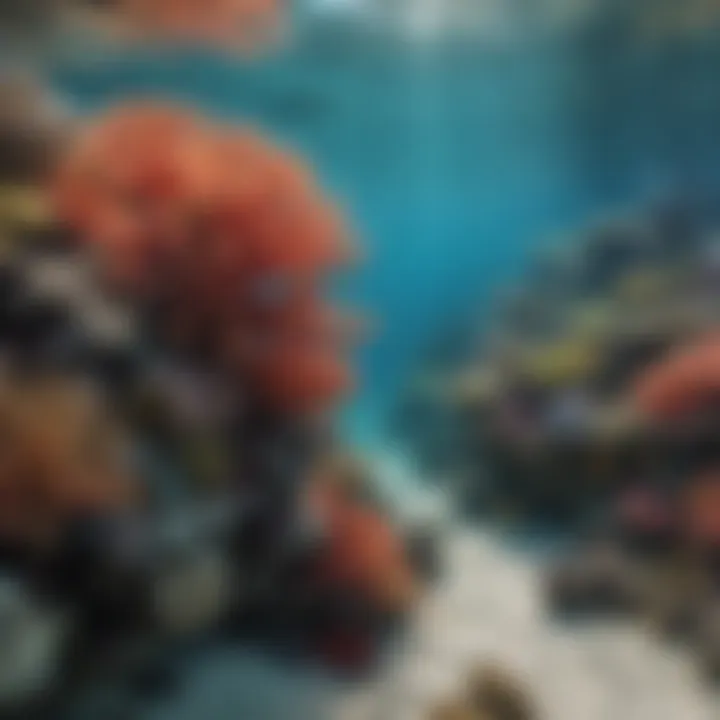
Intro
The ocean is like a giant puzzle, packed with pieces that tell a story of life beneath the surface. Each creature, big or small, plays a role in this intricate ecosystem, balancing nature in ways only a few truly understand. The beauty of the ocean lies not just in its vastness but also in the rich diversity of life it harbors. From the vibrant coral reefs teeming with colorful fish to the shadowy depths where the elusive anglerfish waits in ambush, the marine realm is a treasure trove of wonders waiting to be discovered.
As watersports enthusiasts, researchers, and advocates for marine health, we have a responsibility to understand these fascinating aspects of ocean life. The diversity found in ocean habitats is breathtaking; consider the fact that approximately 230,000 marine species have been classified, but it’s estimated that well over 2 million possibly exist! This richness is why protecting our oceans is crucial.
This article sets out to shine a light not only on the unique species that inhabit our waters but also on their ecological significance, adaptive strategies, and contemporary conservation efforts aimed at ensuring the sustainability of these aquatic habitats.
By the end of this journey through the depths, you’ll appreciate the artistry of interaction between species and the constant struggle against human challenges. From climate change to pollution, marine life faces significant threats, and understanding their world is essential for supporting conservation initiatives.
Now, let's start by gearing up, so to speak, for a closer look into the vibrant life of the seas.
Prologue to Ocean Marine Life
Understanding ocean marine life is like peeking into an enormous, captivating book with every page teeming with stories. The oceans cover over 70% of our planet, hosting an entire universe of creatures, ranging from the smallest plankton to the largest mammals like the blue whale. Each organism plays a vital role in the intricate tapestry of marine ecosystems. The health of these ecosystems is fundamental for not only the aquatic life they harbor but also for human societies that rely on them for food, recreation, and climate regulation.
The significance of marine life extends far beyond its sheer numbers and diversity. It's about the delicate balance maintained within food webs where every species, be it predator or prey, is crucial. For athletes and outdoor enthusiasts, this understanding fuels a passion to respect and safeguard the watery environments they enjoy. Conservation of marine habitats means healthier oceans, benefitting current and future generations. As we dive deeper into this exploration, we can appreciate the profound connections between marine life and our well-being.
Defining Marine Life
Marine life encompasses all living organisms that reside in the ocean. This broad category includes various species—fish, mammals, birds, and countless invertebrates. While the definition seems straightforward, the complexity lies in the myriad of adaptations these organisms possess to survive in diverse ocean environments. From the colorful corals on a reef to the mysterious creatures lurking in the depths of the sea, marine life varies greatly.
Key aspects to consider when defining marine life include:
- Habitats: The ocean is comprised of various habitats such as the surface (epipelagic), the depths (benthic), and niches like hydrothermal vents.
- Species Interactions: Many marine species interact with each other in both symbiotic relationships and competitive scenarios.
- Adaptations: Organisms often evolve unique physical traits and behaviors to thrive in their specific environments.
History of Marine Exploration
The exploration of our seas has a rich history, marked by curiosity and discovery. Initial voyages were often propelled by the desire for trade, such as the pursuit of spices or new lands. For instance, the expeditions of the late 15th century saw figures like Christopher Columbus sailing the oceans with intentions far beyond marine biology, yet inadvertently they opened doors to understanding the intricacies of ocean ecosystems.
As time progressed, scientific curiosity took the wheel. In the 18th and 19th centuries, oceanographic expeditions began to gain traction. Research ships like the HMS Challenger set sail on groundbreaking voyages, collecting invaluable data about ocean temperature, currents, and the creatures that dwell within these watery depths.
Today, we are equipped with advanced technology—submersibles and remotely operated vehicles—that allow us to explore areas previously deemed unreachable. This journey into the ocean's depths continues to reveal astonishing discoveries about life forms that survive extreme conditions.
As we explore the ocean's mysteries, we not only expand our knowledge but also highlight the importance of preserving these ecosystems for future generations. The journey thus far sets the stage for appreciating the marvellous biodiversity present and its intricate roles within our planet's biosphere.
Biodiversity in the Oceans
The oceans, comprising over 70% of the Earth's surface, host an astonishing variety of life forms. Biodiversity in these vast waters is crucial for maintaining ecological balance and ensuring the survival of many species, including our own. Each organism, from the tiniest plankton to the largest whale, plays a key role in the intricate web of marine life.
Firstly, biodiversity supports ecosystem resilience. A diverse array of species can better withstand environmental changes, such as climate fluctuations and pollution. For instance, if one species declines due to disease or habitat loss, others can fill that ecological niche, thus maintaining ecosystem processes. This adaptability is vital, especially in a world facing escalating threats such as climate change.
Secondly, healthy biodiversity can enhance the productivity of marine ecosystems. Different organisms often have complementary roles, such as consuming different types of food or utilizing various habitats. This interaction leads to more efficient nutrient cycling and energy transfer within the ecosystem. A key benefit here is that vibrant ecosystems, like coral reefs, support fisheries that many communities rely on for their livelihoods.
In summary, the biodiversity found in ocean ecosystems serves multiple functions that are indispensable for ecological health and human survival. Supporting these diverse marine life forms is not just an environmental concern—it's also a pressing human issue that impacts food security, economic stability, and our overall well-being.
Types of Marine Organisms
Plankton
Plankton are an essential part of marine ecosystems. These drifting organisms, both plants (phytoplankton) and animals (zooplankton), are foundational to the marine food web. In fact, phytoplankton account for about half of the Earth's oxygen production, making them a significant aspect of global ecology.
One remarkable characteristic of plankton is their ability to be both autotrophic and heterotrophic, meaning some produce their own food while others rely on consuming other organisms. This duality highlights their navigational importance within marine ecosystems, as they provide sustenance for a variety of marine species, from small fish to massive whales.
Plankton's unique feature is their size—a mix of microscopic organisms and some that are barely visible to the naked eye. Their floatation allows them to inhabit various ocean levels, leading to widespread nutrient distribution. However, changes in nutrient levels, such as those caused by pollution, can disrupt their populations and affect the broader marine ecosystem.
Nekton
Nekton refers to the freely moving aquatic animals, such as fish, squid, and marine mammals. Unlike plankton, nekton are strong swimmers and can travel considerable distances in search of food. One key defining feature of nekton is their ability to control their movement, making them versatile predators in the marine environment.
The adaptation of streamlined bodies among many nekton species allows for efficient movement, facilitating the pursuit of prey or evading predators. The role of nekton in ocean ecosystems cannot be overstated, as they are integral to food webs, serving as both predators and prey. However, overfishing presents significant challenges for some nekton species, endangering their populations and jeopardizing marine biodiversity as a whole.
Benthos
Benthos are organisms that live on or in the ocean floor. This diverse group includes everything from tiny crustaceans to massive sea stars. One unique aspect of benthic life is its reliance on the ocean bottom for habitat and nutrients. Organisms like sea cucumbers and various mollusks contribute significantly to nutrient cycling and recycling, breaking down organic material and allowing it to be reused in the ecosystem.
The benthic realm is characterized by its high diversity. Many benthic organisms have adapted to thrive in varied conditions, from sunlit coral reefs to dark depths of the ocean floor. However, benthic habitats face serious threats from human activity, such as deep-sea mining and bottom trawling, which can devastate these fragile environments and disturb the vital balances of the ocean.
Species Richness
Coral Reefs
Coral reefs are often termed the "rainforests of the sea" due to their incredible biodiversity. These vibrant underwater ecosystems house thousands of marine species, providing habitat and food for a plethora of organisms, including fish, crustaceans, and even seabirds. The key characteristic of coral reefs is their complex structure formed by coral polyps, tiny organisms that create limestone skeletons over hundreds of years, forming expansive reef systems.
The ecological significance of coral reefs goes beyond their beauty; they act as natural barriers, protecting coastlines from erosion and providing critical shelter for myriad marine species. However, coral reefs are under severe threat from climate change, ocean acidification, and pollution. The phenomenon of coral bleaching, where stressed corals lose their vibrant colors and turn white, is alarming and signals the degradation of these ecosystems.
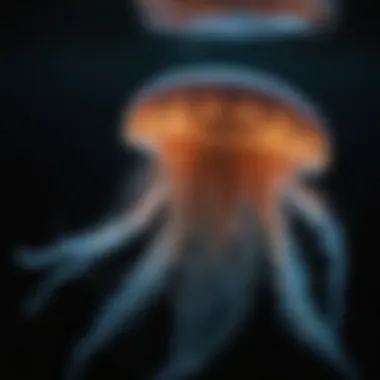
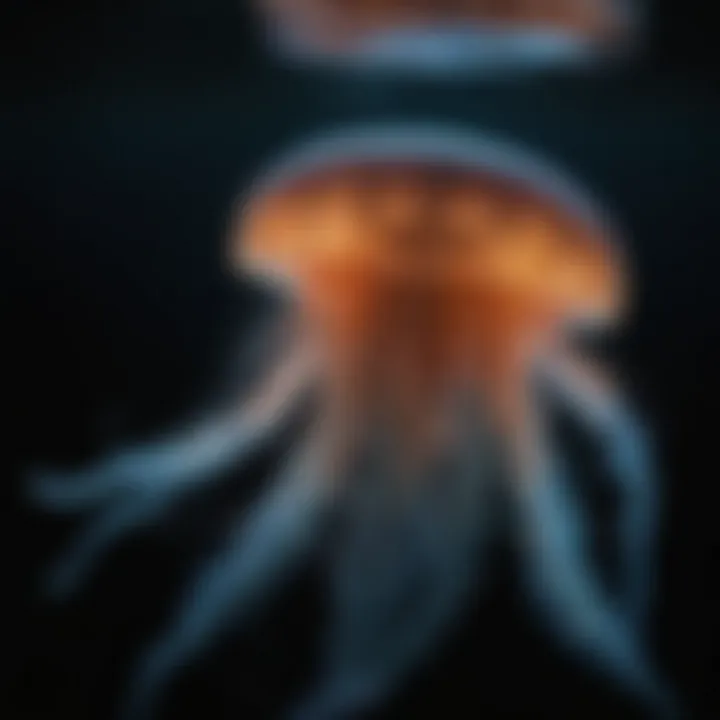
Deep-Sea Communities
Deep-sea communities represent one of the least explored frontiers of marine life, located often thousands of meters below the surface. Despite extreme environmental conditions, including high pressure and complete darkness, many organisms thrive in this unique habitat. A notable feature of deep-sea life is its adaptation to scarcity—many species, such as certain types of bioluminescent jellyfish, have evolved remarkable traits to attract prey or communicate in the dark depths.
The role of these communities in global ecosystems is also significant as they contribute to nutrient cycling and support specialized predator-prey relationships. However, the deep sea remains vulnerable to threats like deep-sea mining and the impacts of climate change, which can disrupt these long-established ecosystems. Understanding these profound depths is paramount for marine conservation efforts and the broader comprehension of ocean biodiversity.
Ecosystems of the Ocean
The ecosystems in the ocean are intricate webs of relationships and interactions that sustain not just marine life but also influence global weather patterns and the health of our planet. Each ecosystem contributes uniquely to biodiversity, offering habitats for countless species. They play a vital role in nutrient cycling, energy transfer, and even in providing some of the oxygen we breathe. Understanding these ecosystems is crucial, as they’re facing formidable threats threatening their delicate balance.
Coral Reefs
Structure and Function
Coral reefs are often dubbed the rainforests of the sea due to their immense biodiversity. These structures are built by tiny animals called coral polyps, which secrete calcium carbonate, forming the actual reef. The relationship between these polyps and the colorful zooxanthellae algae is particularly fascinating. They engage in a sort of symbiotic dance; the algae provide essential nutrients through photosynthesis, while the corals offer a protective environment.
One key characteristic of coral reefs is their complex structure. They consist of various forms, including fringing reefs close to shore and barrier reefs separated by lagoons. This complexity feeds the rich marine life that thrives there. Reef systems not only protect coastlines from erosion, but they also serve as a nursery ground for many fish species.
However, coral reefs don’t come without their challenges. The unique feature of their structure can also make them vulnerable to climate change and ocean acidification. When water temperatures rise, corals expel their algae—a phenomenon known as coral bleaching—leading to increased mortality rates. The fragility of these structures thus poses both advantages in biodiversity support and disadvantages regarding their resilience to environmental changes.
Threats
The threats to coral reefs are numerous and alarming. Pollution, overfishing, and global warming all put significant pressure on these ecosystems. One prevailing issue is the increase of carbon dioxide in the atmosphere, which directly affects ocean chemistry, leading to higher acidity levels. Such acidification impairs corals' ability to produce carbonate, threatening their structural integrity.
A striking characteristic of current threats is their complexity; they often intertwine making it hard to isolate a single factor causing damage. For example, when coastal development results in run-off, this pollution not only harms coral but also the myriad species that depend on them for survival. Unique features include how some reef species exhibit resilience to stressors and have adapted to changing conditions, but this is not universal and does not apply to all species. Thus, while conservation efforts can be made, the disadvantages faced are steep, and addressing these threats is essential for the future of marine biodiversity.
Ocean Floor Habitats
Mud and Sand
Mud and sand habitats, often overlooked, are critical components of marine ecosystems. They serve as a foundation for various organisms, providing a substrate for benthic life. The grains of sand and clays play host to a variety of species, from tiny invertebrates to larger filter feeders, all of which contribute to nutrient cycling within the ecosystem.
A notable aspect of these habitats is their ability to trap organic material that sinks from above, providing a food source for organisms that thrive on the seafloor. This process creates a vibrant community of detritivores—organisms that feed on dead organic matter—playing a vital role in recycling nutrients back into the ecosystem.
However, relying solely on biomasses here leads to disadvantages, as these habitats can become nutrients-poor areas, limiting the diversity of life. The unique feature of being a natural filter offers benefits, yet makes these habitats vulnerable to pollution and habitat destruction from human activities.
Hydrothermal Vents
Hydrothermal vents are one of the ocean's most intriguing habitats. They spew superheated, mineral-rich water from beneath the Earth's crust, creating a unique ecosystem that exists independently from the sun’s energy. Instead, life there relies on chemosynthesis; certain bacteria convert the chemicals in the vent emissions into energy.
What stands out about hydrothermal vents is the extraordinary range of life they harbor, from giant tube worms to unique shrimp species. This biodiversity presents an insightful look into how life can adapt under extreme conditions and provides a potential model for life on other planets.
But not everything is rosy with these ecosystems; they face the threat of deep-sea mining and climate change. The unique characteristic of their isolation makes them fragile; once destroyed, recovery can take millennia. Thus, while hydrothermal vents represent resilience, they are not immune to human impacts and warrant protection for future research and understanding of deep-sea ecology.
The ocean's ecosystems are not merely backgrounds; they are living networks that sustain life and regulate our planet's climate. Protecting them is not just an environmental issue; it's a matter of global vitality.
Adaptations of Marine Life
The oceans are a sprawling expanse, home to a diverse array of creatures shaped by millennia of evolution. Understanding adaptations of marine life sheds light on how these organisms not only survive but thrive in challenging environments. These adaptations, both physiological and behavioral, allow marine species to cope with everything from fluctuating water temperatures to the hunt for food. Through these adaptations, each organism plays a role that in the grand tapestry of ocean ecosystems underscores the importance of preserving marine life.
Physiological Adaptations
Temperature Regulation
One key area of physiological adaptation is temperature regulation. Fish and other marine species have developed mechanisms to handle the cold depths of the ocean or the warmer surface layers. Some species, like the Arctic cod, produce special proteins known as antifreeze glycoproteins that prevent their blood from freezing. This characteristic is vital, as it allows them to occupy niches in harsh climates where few other creatures can thrive.
The benefits of temperature regulation can't be overstated. It not only enhances survival rates but allows for reproduction in optimal conditions—all crucial for the sustainability of populations. However, it also comes with limitations. For instance, extreme temperature variations can stress these organisms, affecting their health and breeding success.
Osmoregulation
Another significant physiological aspect is osmoregulation, which refers to how marine animals maintain the balance of water and salts in their bodies. Most marine fish are hypotonic, meaning they lose water to the salty sea. To compensate, they drink seawater and excrete the excess salts through specialized cells in their gills. This adaptation is crucial for their survival in a high-salinity environment.
The uniqueness of osmoregulation lies in its critical function. Without it, fish would quickly dehydrate, leading to a domino effect that could devastate populations. Yet, the process can be energy-intensive. Those fish that can’t adapt effectively to salinity changes may struggle, showing the survival of the fittest in action in our oceans.
Behavioral Adaptations
Migration Patterns
Migration patterns represent a fascinating behavioral adaptation observed in numerous marine species, especially in species like salmon that travel great distances to spawn. These journeys are often perilous but essential for ensuring the next generation is born in nutrient-rich waters. Migration serves many purposes, such as escaping predators or finding food, making it a critical survival strategy.
Considering this trait, one might wonder why such energy-consuming travels are so prevalent. The unique feature of these patterns adds to the resilience of marine life. However, they come with disadvantages too, such as increased vulnerability during the journey and challenges posed by environmental changes due to climate change.
Feeding Strategies
Diving into feeding strategies, marine organisms exhibit a wealth of behaviors from the surface to the deep. Some, like the blue whale, filter massive volumes of water to extract tiny krill, while others, such as great white sharks, have adaptively evolved to be apex predators. Such distinct methods are essential for obtaining energy and nutrients from the surrounding ecosystem.
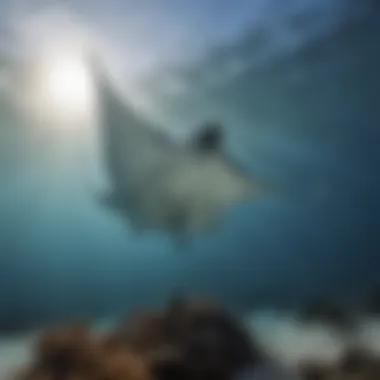
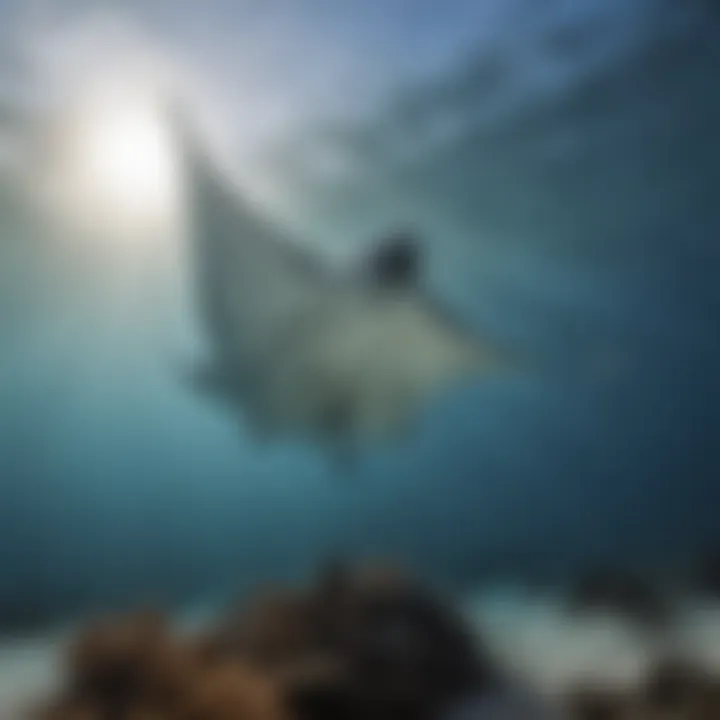
What sets these strategies apart is their adaptability. As prey availability changes, many species have shown flexibility in their diets. However, this can lead to competition and conflict among species. Additionally, those species that are overly specialized may find themselves in dire straits if their primary food sources diminish due to environmental pressures.
The complexity of marine life adaptations illustrates the sophisticated interplay between organisms and their environments. Adaptations are not merely survival tactics; they represent a finely tuned balance shaped by evolution.
Understanding these adaptations is crucial, as they paint a vivid picture of how species navigate the many challenges of their underwater world. As stewards of the oceans, recognizing and respecting these adaptations may guide our conservation efforts, ensuring the diverse life forms continue to flourish.
Role of Marine Life in Ecosystems
Understanding the role of marine life in ecosystems is like figuring out the pieces of a complex puzzle. Every creature, from the tiniest plankton to the magnificent blue whale, has a part to play in maintaining the balance of ocean life. This balance is crucial, not just for the ocean but for the health of our planet.
Marine life contributes significantly to various ecological processes. The interaction of species helps in nutrient cycling and supports the broader web of life that we see in oceans. These interactions form the foundational basis for sustaining life in aquatic environments, which in turn affects terrestrial ecosystems due to the interconnectedness of global water cycles.
Nutrient Cycling
Nutrient cycling in marine environments is essential for the vitality of ecosystems. Think of nutrients as the lifeblood of the ocean – without them, marine life could not thrive. Various organisms, including phytoplankton and zooplankton, work tirelessly to recycle nutrients, aiding in the growth of biological communities.
- Phytoplankton play a pivotal role as primary producers, converting sunlight into energy through photosynthesis. They form the base of the food chain, supporting a myriad of other marine species, including small fish and large whales.
- Decomposers, like bacteria and fungi, break down dead organic matter, releasing nutrients back into the water column. This process not only enriches the water but also enhances overall marine productivity.
Marine environments also have nitrogen and phosphorus cycling that promote algae growth, which in turn influences the entire ecosystem's health. However, when these cycles are disrupted, say by pollutants, it can lead to issues like harmful algal blooms, affecting everything from marine species to human health.
"The ocean is a complex system that depends on the balance of nutrients, which are critical for sustaining life."
Food Web Dynamics
Food webs in the ocean feature intricate connections that determine the fate of various species. Picture a vast, underwater tapestry woven with countless threads – each thread represents interactions between organisms. At the heart of these relationships are predator-prey dynamics, where the balance of populations affects the entire ecosystem.
- Top predators, like sharks and orcas, help control the populations of other marine species, ensuring no single group overpopulates and disrupts the ecosystem.
- Herbivores, such as sea urchins and certain fish, regulate the growth of seaweed. In areas where these grazers are overfished, unchecked algal growth can occur, leading to detrimental changes in habitat and loss of biodiversity.
The food web reflects a delicate balance; when changes happen in one area, they can send ripples throughout the entire ecosystem. For athletes and outdoor enthusiasts who dive or fish, understanding these dynamics enriches their appreciation for marine environments, highlighting that every catch or sighting impacts the broader ecosystem.
Marine life doesn't just contribute to a microlandscape; it supports global systems, impacting weather patterns, oxygen production, and nutrient distributions, which ultimately sustains life on land as well. Acknowledging and preserving these roles in marine ecosystems is key for today's environmental advocates.
Marine Life and Human Interaction
Understanding how humans interact with marine life is essential, especially in a time when our oceans are facing numerous challenges. The relationship between ocean health and human practices is crucial, as it shapes marine ecosystems and influences our livelihoods. This section will elevate our comprehension of how fishing practices, tourism, and recreational activities impact the delicate balance of marine life.
Fishing Practices
Sustainable Practices
When talking about fishing practices, the sustainable angle is often highlighted nowadays. Sustainable fishing practices focus on ensuring that fish populations and the ecosystem remain healthy for future generations. This approach promotes a careful balance, allowing fish to reproduce while still providing for local communities. The key characteristic here is the long-term viability of fish stocks, which not only benefits the environment but also supports economic stability in regions reliant on fishing.
A unique feature of sustainable practices includes methods like catch-and-release, which helps maintain fish populations. The advantages are manifold: they reduce overfishing, help maintain the biodiversity of marine life, and foster healthier ecosystems. However, it does require cooperation among fishers, local communities, and regulatory bodies, creating a cohesive effort that can challenge traditional fishing habits.
Overfishing Challenges
On the flip side of the coin, overfishing remains a pressing issue. This challenge arises when fish are caught at a faster rate than they can reproduce. The global demand for seafood contributes directly to this problem, leading to severe declines in fish populations and disrupting marine food webs. A key characteristic of overfishing is the target on commercially viable fish species, which can have devastating ripple effects across entire marine ecosystems.
A striking unique feature of overfishing is its often invisible nature, as it can take years before the consequences become evident. This delayed feedback loop can lead to irreversible damage, posing a real dilemma for future fishing viability. The disadvantages of overfishing not only threaten marine biodiversity but also the economic livelihoods of communities reliant on fishing.
Tourism and Recreation
Impact on Marine Life
Tourism can bring both benefits and setbacks for marine ecosystems. On the one hand, marine life draws millions of visitors each year. Activities such as snorkeling and diving can raise awareness about the beauty and fragility of ocean habitats. However, the impact on marine life from increased human activity poses threats, from habitat destruction to pollution. A crucial characteristic here is how tourism can sometimes neglect environmental limits, leading to degradation of delicate marine environments.
The unique feature of this interaction is that while tourism has the potential to promote conservation, it often requires strict management policies. Advantages include increased funding for marine protection; disadvantages can involve crowding and ecological damage if improperly managed.
Economic Benefits
Let’s not overlook the economic benefits derived from marine tourism. Coastal communities often thrive on the influx of tourists eager to explore underwater wonders. The industries related to this tourism — including hotels, maritime travel, and local markets — create job opportunities and foster economic growth. The key characteristic of economic benefits lies in job creation and improved livelihoods, enabling communities to invest in conservation efforts as they gain from the economic influx.
However, the reliance on tourism can also lead to vulnerability during off-seasons or economic downturns. A unique feature of this sector is the balance between profit and sustainability — while tourism brings funding, it can also lead to exploitation of marine resources if left unchecked. Striking a balance becomes paramount, ensuring that while communities benefit economically, they also foster a culture of stewardship toward the oceans.
"Healthy oceans are not just vital for marine life; they are the lifeblood of coastal economies and communities."
By understanding and improving these intersections among fishing practices, tourism, and recreation, we can work towards a future where human interaction with marine life is respectful and sustainable.
Conservation of Marine Life
The conservation of marine life is not just a trendy buzzword in environmental circles—it's a necessity for the survival of many species and the wellbeing of our oceans. With the seas facing numerous threats, conservation efforts aim to protect the delicate balance of marine ecosystems. The stakes couldn't be higher; healthy oceans contribute significantly to global biodiversity, climate regulation, and economies dependent on marine resources.
Major Threats to Marine Biodiversity
Pollution


Pollution remains a daunting adversary for marine ecosystems. Everyday activities—such as industrial manufacturing and agricultural runoff—stream contaminants into the ocean. Plastic waste, one of the worst offenders, is a particularly dire issue. It's estimated that by 2025, the oceans could have more plastic than fish by weight if current trends continue. That's no small fish tale.
What's alarming about pollution is its pervasive nature. Microplastics, for example, infiltrate even the most remote areas of the ocean, disrupting the food chain and threatening marine life. Fish and other creatures ingest these particles, which can then cascade up the food chain, impacting humans as well. This makes pollution a critical concern in any discussion on marine conservation, as it serves as a glaring reminder of human impact on our planet.
"The ocean is a symbol of our planet's health; its degradation speaks volumes of our collective failure to care for it."
Climate Change
Climate change is the proverbial elephant in the room when discussing marine conservation. It affects ocean temperature, sea levels, and acidity, resulting in widespread changes in marine habitats. For example, rising sea temperatures contribute to coral bleaching, leaving reefs vulnerable and devoid of life. Coral reefs, often referred to as the rainforests of the sea, provide habitat for a plethora of marine species. Their decline foreshadows a ripple effect on biodiversity.
Additionally, increased levels of carbon dioxide lead to ocean acidification, which impacts shellfish and other calcifying organisms. Their inability to build shells threatens not only their survival but also the fishermen and communities that rely on them. Hence, addressing climate change is paramount in any conservation conversation, making it an unavoidable topic for enthusiasts and researchers alike.
Conservation Efforts
Marine Protected Areas
Marine Protected Areas (MPAs) have gained traction as a powerful tool for safeguarding marine biodiversity. These designated regions help preserve vital habitats and species from the detrimental impacts of human activities. By restricting specific activities—like fishing or oil drilling— MPs can promote recovery in over-exploited ecosystems.
A standout characteristic of MPAs is their variability. Ranging from fully protected zones to areas with limited activities, they can be tailored to suit diverse ecological and cultural needs. These zones serve as havens for myriad marine life, allowing ecosystems to regenerate. The 2030 Agenda for Sustainable Development emphasizes their importance, leading to a global commitment to conserve at least 10% of coastal and marine areas.
Community Involvement
Community involvement in marine conservation is not merely optional; it's essential. Local communities play a crucial role in conservation success stories, intertwining their cultures and livelihoods with ocean health. When community members engage in conservation efforts, there’s a notable sense of ownership—resulting in better protection of marine resources.
One unique feature of community involvement is the grassroots movements that arise. Locals, motivated by personal connections to the ocean, often lead initiatives that bring awareness to critical issues such as overfishing and pollution. Their intimate knowledge of the waters can significantly bolster conservation strategies effectively addressing specific local challenges. Moreover, involving communities builds stronger support networks, enhancing the chances for sustainable solutions that resonate with those directly impacted.
The Future of Ocean Marine Life
The future of ocean marine life hinges on our collective actions and understanding of the intricate relationships between species and their environments. With the rise in human activities detrimental to the oceans, it becomes paramount to engage with innovative solutions and foster international cooperation. The decisions we make today can either pave the way for thriving ecosystems or lead to irreversible damage. Given the ocean's role in regulating climate and supporting biodiversity, our responsibility toward it is profound.
Research and Innovation
Technology in Conservation
Technology plays an essential role in conservation efforts for ocean marine life. The use of remote sensing technologies allows scientists to monitor changes in marine environments in real time. This capability is crucial for tracking the health of coral reefs, assessing fishing practices, and managing marine protected areas. What sets this technology apart is its ability to provide large-scale data that would be impossible to gather manually, making it easier to identify problematic areas that require immediate attention.
One unique feature of technology in conservation is drones. They not only help survey hard-to-reach areas but also collect data on fish populations and even detect illegal fishing activities. This increased oversight translates into better enforcement of regulations. However, challenges remain; relying too heavily on technology can sometimes lead to oversight in local knowledge and experiences, essential components in successful conservation strategies.
Studying Deep-Sea Ecosystems
The exploration of deep-sea ecosystems is becoming ever more vital as we seek to understand the lasting impacts of human actions on these remote areas. What makes studying the deep-sea particularly interesting is the discovery of extremophiles—organisms that thrive in harsh conditions. These creatures can reveal insights into resilience in marine environments and hold potential for biotechnological advancements.
A unique aspect of deep-sea studies is the use of submersibles and remotely operated vehicles (ROVs). These instruments allow researchers to reach depths where sunlight doesn’t penetrate and explore environments rich in biodiversity yet vulnerable to climactic shifts and pollution. The main advantages lie in the ability to document never-before-seen phenomena, though the costs and technical challenges of such research can be a barrier to comprehensive exploration.
Global Cooperation
International Agreements
Global cooperation through international agreements is key to preserving marine life. Treaties such as the United Nations Convention on the Law of the Sea provide a framework for states to manage marine resources sustainably. These agreements leverage collective action to develop strategies aimed at curbing pollution, managing fisheries, and creating marine protected areas.
The beauty of these treaties lies in their ability to unify countries around a common cause and establish guidelines that govern human activities in the ocean. However, enforcement remains problematic; without consistent commitment from every country involved, the effectiveness of these agreements diminishes significantly.
Collaborative Research Initiatives
Collaborative research initiatives represent a powerful way to pool expertise and resources for marine conservation. By facilitating partnerships among governments, academic institutions, and NGOs, these initiatives can address complex challenges in a multifaceted manner. For instance, the Ocean Biodiversity Information System collects data that researchers globally can access to inform their conservation efforts.
Key characteristics of these initiatives include sharing data and technology, which fosters a better understanding of ocean dynamics and protects marine biodiversity. The main advantage is a more holistic approach to issues, drawing on diverse inputs and insights. However, the challenge lies in navigating differing priorities and ensuring equitable contributions from all involved parties.
"The health of our oceans is not just a local issue; it's a global responsibility that requires collaboration at every level."
In navigating the future of ocean marine life, leveraging technology, collective agreements, and collaborative initiatives must be central to our strategy. If these pathways are pursued diligently, the horizon for ocean conservation can look much brighter.
Finale
The exploration of ocean marine life offers a treasure trove of insights into how this vast ecosystem operates and the myriad of species that call it home. It’s not just about understanding fish and coral; it spans a complex web of interrelations that sustain life on Earth. Recognizing the value of this information is crucial for anyone invested in the health of our oceans.
Summarizing Key Insights
Throughout this article, we’ve delved into the incredible diversity of marine life, from the tiniest plankton to the majestic whales. Here are some takeaways worth highlighting:
- Diversity of Species: Oceans are home to millions of species, many yet to be discovered. Coral reefs alone host a quarter of all marine species, reflecting an astounding level of biodiversity.
- Ecosystem Functions: Marine life performs key ecological roles, such as nutrient cycling and supporting food webs, which are foundational to ocean health. A disruption in one part can lead to catastrophic consequences.
- Adaptations and Resilience: Many organisms exhibit remarkable adaptations. Take for instance the deep-sea anglerfish, which utilizes bioluminescence to survive in darkness. Such traits are marvels of evolution, showcasing nature’s ingenuity.
- Threats and Conservation Needs: From climate change to pollution, the threats faced by marine life are daunting. Understanding these challenges is the first step toward fostering better strategies for conservation.
In summary, the health of marine ecosystems directly influences human well-being. Acknowledging our role in this dynamic system can foster a sense of responsibility.
Call to Action for Ocean Advocates
There’s no time like now to step up for our oceans. What can you do? Here are some actions anyone can consider:
- Educate Others: Share knowledge about marine biodiversity and conservation challenges with friends, family, or community members. Understanding is the first step towards action.
- Support Sustainable Practices: Whether you’re fishing or diving, prioritize sustainable practices. Make informed choices that minimize harm to marine habitats.
- Get Involved in Cleaning Efforts: Participate in beach clean-ups or advocacy programs aimed at reducing pollution. Every little bit helps.
- Advocate for Policy Changes: Push for policies that protect marine life. Support legislation aimed at sustainability and conservation efforts.
- Join Online Communities: Engaging with platforms like reddit.com can connect you with other ocean advocates and keep the conversation going.
"We do not inherit the earth from our ancestors; we borrow it from our children." This quote encapsulates the essence of our duty toward marine life and the ecosystems we depend on.
As we stand at the precipice of significant environmental change, it's vital to act decisively and with purpose, ensuring the oceans remain vibrant and healthy for generations to come. Each individual can contribute to this goal, creating a ripple effect that can lead to substantial change. The oceans are calling, and it's up to us to respond.















